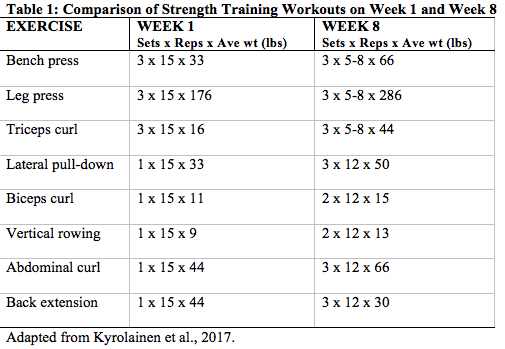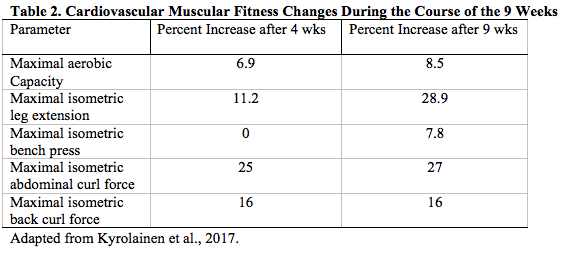Training Guidance for Sedentary Young Women
Len Kravitz, PhD
Study Reviewed:
Kyrolainen, H., Hackney, A.C., Salminen, R. et al. (2017). Effects of combined strength and endurance training on physical performance and biomarkers of health young women.
Introduction
There is a fair amount of published research on the effects of muscular strength and cardiovascular endurance with populations of men and women between the ages of 18 and 22. This is primarily due to the number of studies completed with college student populations. However, one major gap in exercise for health research is with sedentary women aged 25 to 30 years. This chronological time frame often represents a life transition from college to work. Kyrolainen et al. (2017) highlight this period in a woman's life may be difficult to find time to meet exercise recommendations of various health organizations, such as the World Health Organization and Centers for Disease Control. In addition, the authors note there is little published research on how much training and what kind of progression is optimal for this population of women. Thus, the purpose of this study was to investigate the influence of a combined cardiovascular endurance and muscular strength program on several parameters of health and well-being in sedentary young women.
Participants
Seventeen sedentary, overweight and/or obese women (25-30 yrs; ave wt.=160 lbs, BMI=25.7, %body fat=32.8) involved primarily in office working occupations volunteered for this study. All participants were instructed not to begin any other sports activities or exercise programs during the 9 weeks of the study. There was no dietary intervention in this study. All volunteers were encouraged to maintain their current dietary lifestyle. However, the researchers had the participants complete 3-day (with 1 weekend day) food diaries for every week of the study.
Testing
Aerobic capacity was measured using a graded exercise test on a cycler ergometer. The participants began with a 75-watt load, which was increased 25 watts every 2 minutes until the participants reached exhaustion.
Maximal isometric strength (holding for 3 seconds near the midpoint of the joint movement) was completed on the leg extension and arm extension. Participants also did a 1RM and 10RM in full range of motion leg extension. For abdominal and back measurements, in a fixed vertical position using a strain gage to measure force, participants completed maximal isometric (3 second hold) extension (for the back) and flexion (for the abdominals). Bench press strength was tested with maximal isometric bench press movement at 90 degrees (with shoulders and elbows).
Blood samples were taken to measure total cholesterol, high-density lipoprotein cholesterol, low-density lipoprotein cholesterol, glucose, triglycerides (blood fats), testosterone, cortisol, and estradiol.
Body composition was measured using bioelectrical impedance analysis. This body composition method determines the electrical opposition (called impedance) to the flow of an electric current through body tissues. It initially estimates total body water, which can be used to estimate percent fat and muscle in the body.
Training Intervention
In this 9-week study, the participants trained 3 times a week. During the first 7 weeks, they performed 2 supervised strength-training workouts and one cardiovascular training session each week. During the last 2 weeks of the study, the participants performed 2 cardiovascular endurance workouts and one strength training session each week. The cardiovascular workouts consisted of researcher-led indoor cycling classes, initially for 30 minutes and progressing over the 9 weeks to 55 minutes by the end of the study. Participants trained at 85% to 91% of their maximal oxygen uptake, which is a hard to very hard exercise intensity.
For the supervised resistance training program, Table 1 presents the exercises, sets, repetitions and average load for the participants in Week 1 and Week 8. The recovery interval between sets at the start of the training was 45-60 seconds. As the intensity increased, during the course of the study, the recovery progressed to 120-150 seconds. Notice the progression in sets, repetitions, intensity and load.
|
 |
Results and Discussion:
The researchers completed the testing at the start of the study, midpoint (after 4 weeks), and after the 9-week intervention (See Table 2 for summary). Completing the midpoint testing provides additional insight for when the adaptations were occurring. For instance, in maximal aerobic capacity, the average increase for all participants was 8.5%. By week 4 the participants attained an increase of 6.9% in maximal aerobic capacity. This finding is quite interesting because participants were only completing one cardiovascular workout a week during the first four weeks of the study. Kyrolainen et al. (2017) observe that previous studies with similar sedentary populations lasting 12 to 14 weeks have shown approximately 13% to 20% increase in maximal aerobic capacity. Naturally, initial fitness level, exercise training intensity, weekly frequency and weekly duration all factor into the varying degrees of aerobic improvement.
Maximal isometric leg extensor strength increased 28.9% in the 9 weeks with 11.2% of the increase occurring by week 4. In contrast, an average maximal isometric bench press increase of 7.8% was observed, but this increase did not occur until the after the first 4 weeks of training. Thus, this midpoint testing reveals a dissimilar time frame adaptation between upper body and lower body with this sedentary group of women. The full range of motion leg extension increased 32% in the 1RM and 46% in the 10RM. Isometric abdominal curl force increased 25% after the first 4 weeks and then attained 27% after week 9. Similarly, maximal back curl force increased 16% after the first 4 weeks, with no additional improvement during the next 5 weeks of the study. Once again, this midpoint of measurement provides very interesting data on the time frame of adaptation and magnitude of the adaptation occurring during the first 4 weeks of training.
The blood parameter research conducted in this study reveals some significant health implications. There was an overall 8.8% increase in the high-density lipoprotein cholesterol (HDL-C) by week 9. An elevation of HDL-C, the good cholesterol, is a very positive outcome. In addition, another positive change was the 7.6% decrease in total cholesterol. No changes were noted with testosterone, glucose and estradiol. It should be noted that the weekly food diaries indicated no change during the 9 weeks in the amount of food intake, nor the daily percentage of fat, carbohydrate and protein in the dietary habits.
Another interesting finding of this study was the 22.7% increase in cortisol levels over the 9 weeks of the study. The researchers hypothesize this increase may be a positive result of improved fat metabolism from the training, as cortisol is a key hormone involved in regulating fat breakdown.
In regards to body composition, from a practical comparison, there was no overall meaningful change in percent muscle mass (Pretest=26.4%; Posttest=26.6%) or percent body fat (Pretest=32.8%; Posttest=32.0%). Kyrolainen et al. (2017) note that previous studies show more noteworthy changes in body composition when total calorie and macronutrient intake are modified, along with the exercise intervention. However, the goal of this investigation was to best observe the combined effects of cardiovascular exercise and resistance training to all parameters measured.
Summary Thoughts
As most readers recognize from reading this research review, one limitation of the study is the lack of a control group. However, to minimize this limitation, the researchers completed two pretest periods, separated by one week, to establish very stable baseline measurements of all variables measured. Importantly, from a health perspective, the results of this study support known benefits of physical activity indicating a physically active lifestyle has a positive impact in modifying risk factors of chronic diseases such as cardiovascular disease, hypertension, type 2 diabetes and stroke (McKinney et al., 2016). And perhaps one of the most interesting findings was with the midpoint measurement revealing how fast several physiological parameters adapt in this population of sedentary women. That is really encouraging news!
|
 |
@bio:Len Kravitz, PhD, CSCS, is the program coordinator of exercise science at the University of New Mexico, where he received the Outstanding Teacher of the Year and Presidential Award of Distinction. In addition to being a 2016 inductee into the National Fitness Hall of Fame, Len was awarded the 2016 CanFitPro Specialty Presenter Award.
Additional References:
McKinney, J., Lithwick, D.J., Morrison, B.N., et al. (2016). The Health benefits of physical activity and cardiorespiratory fitness. British Columbia Medical Journal 58(3), 131-137
https://www.bcmj.org/articles/health-benefits-physical-activity-and-cardiorespiratory-fitness
Accessed August 24, 2018
|
|
|
|